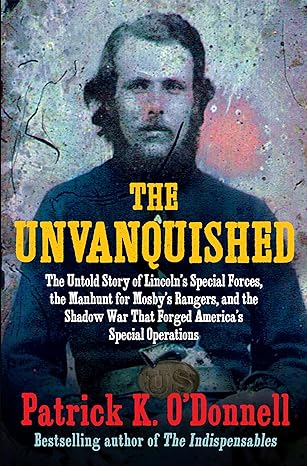The Unvanquished
 ISBN: 978-0802162861
ISBN: 978-0802162861
Patrick K. O’Donnell has tackled an obscure corner of history. In part, this history is obscure because it is at the roots of America as a country. The other part of this relatively occulted subject occurs because the topic concerns clandestine units that operated spy rings during the Civil War.
The two units focused on are the Northern Jessie Scouts, and the Southern Rangers. Both of these units dress up in the other army’s colors with the objective of gathering intelligence, gaining kills, and taking prisoners. The phrase “All is fair in love and war”, springs to mind.
At times, it is hard to keep track of which units are impersonating who. Fortunately, there is an index in the back that lists the characters and their affiliations. If the reader knows this going in, it probably will prove a necessary and valuable asset to ameliorate this potential issue. If not, one often has to read the context carefully to be sure one is remembering who is on what side. It is not always easy either to keep track of who has actually changed sides and who might be a double agent.
Nonetheless, O’Donnell is advancing several conclusions in this work. The biggest piece which stands out concerns who knew what and when where the assassination of Lincoln took place. It is not especially giving a spoiler to say that the conclusion he draws is “many units of the South”. The reason this is not the spoiler one might imagine is that how O’Donnell arrives at this deduction concerns analying many convuluted movements and communications occurring within the Southern armies–particulary during the waning days of the war.
The next important thesis concerns how the movements of the Rangers under Mosby are used as a type of instruction manual for irregular warfare units during World War II as practiced by the OSS. (Office of Strategic Services)
A definition might prove valuable here for the casual non-military reader concerning irregular warfare and regular warfare (conventional):
“Irregular warfare (IW) is defined by the Department of Defense as “a violent struggle among state and not-state actors for legitimacy and influence over the relevant populations. IW favors indirect and asymmetrical approaches, though it may employ the full range of military and other capabilities, in order to erode an adversary’s power, influence, and will.” source: https://www.red-inc.us/irregular-warfare/overview/
In other words, irregular warfare involves spy and psychological kinds of operations. Conventional warfare, on the other hand, is more direct with various members of both armies attempting to obliterate one another on the battlefield using traditional weapons.
If you mix the two together, the result is a “hybrid” kind of warfare which uses both methods of battle with the goal being the ultimate victory of one side or the other.
Mosby’s rangers are very good at this kind of warfare and use what might be an early form of blitzkrieg method of attack utilizing calvary before disappearing into the surroundings. The North develops intelligence gathering ability, however, through the intervention mostly of a man by the name of Phillip Sheridan. Sheridan would eventually go on to become a four-star general. The North wins mostly by gathering intelligence. The South gains many of its victories owing to Mosby’s lightning fast guerilla tactics. Both, of course, were adopted in military strategies on many sides in future wars.
The South is also not without its intelligence units and respective secret services, but it seems they are often inefficient in the narrative or else are simply outmanuevered or outmanned. Often, however, their plans do not succeed by very narrow margins. O’Donnell does a great job of illustrating these kinds of moments and includes a story about one officer who might have changed the outcome of the war simply by having gone fishing.
One thing missing from O’Donnell’s account which plays a part into this story is how not just Lincoln’s enemies conspired to kill him. Indeed, there were many that called themselves friends of Lincoln who behaved quite strangely before his death. More than a few were in close proximity to people like Booth and mixed among him and people like Lewis Powell. Everyone wanted to become rich on cotton, and the South had a lot of it to sell. Many wanted Lincoln out of the way, because he was not radical enough in his positions for either the North or the South. So while the thesis of the book points to the death of Lincoln being heavily a Southern invention, the subsequent actions of many in the north who wanted to be President and have power to rebuild the nation after the civil war cannot be overlooked or understimated. What O’Donnell does well, however, is establishes that many in the South were playing ignorant of a desired outcome to evade justice. All of them, in this work, look guilty. They surely were not lacking in apparatus to organize insurrections which they pursued, and they definitely were not wanting when it came to organizing something on the scale of an assassination. That many were not held liable for this is the blind eye history likes to turn in changing the page to the next moment of peace before conflict.